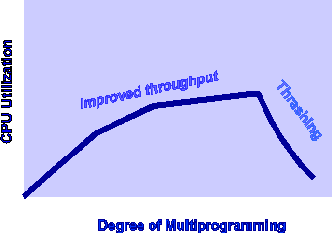

Thrashing occurs when a system spends more time processing page faults than executing transactions. [S1] While processing page faults is necessary to in order to appreciate the benefits of virtual memory, thrashing has a negative affect on the system.
As the page fault rate increases, more transactions need processing from the paging device. The queue at the paging device increases, resulting in increased service time for a page fault . While the transactions in the system are waiting for the paging device, CPU utilization, system throughput and system response time decrease, resulting in below optimal performance of a system .
Thrashing becomes a greater threat as the degree of multiprogramming of the system increases.

This graph shows that there is a degree of multiprogramming that is optimal for system performance CPU utilization reaches a maximum before a swift decline as the degree of multiprogramming increases and thrashing occurs in the over-extended system. This indicates that controlling the load on the system is important to avoiding thrashing. In the system represented by the graph, it is important to maintain the multiprogramming degree that corresponds to the peak of the graph.
The selection of a replacement policy to implement virtual memory plays an imporant part in the elimination of the potential for thrashing. A policy based on the local mode will tend to limit the effect of thrashing. In local mode, a transaction will replace pages from its assigned partition. Its need to access memory will not affect transactions using other partitions. If other transactions have enough page frames in the partitions they occupy, they will continue to be processed efficiently.
A replacement policy based on the global mode is more likely to cause thrashing. Since all pages of memory are available to all transactions, a memory-intensive transaction may occupy a large portion of memory, making other transactions susceptible to page faults and resulting in a system that thrashes.
Other ways of preventing thrashing include using the working set strategy, prepaging a transactions partition, and increasing page size.
